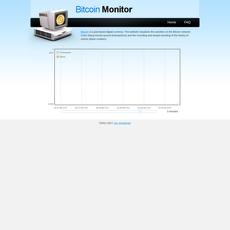Learn Me a Bitcoin Review
Learn Me a Bitcoin
learnmeabitcoin.com
Learn Me A Bitcoin Review Guide: What It Is, How To Use It, and Your Big Questions Answered
Ever wished someone would explain Bitcoin without the buzzwords, hype, or confusing rabbit holes?
I’ve spent years testing crypto education sites, and Learn Me A Bitcoin (LMAB) is one I keep returning to. It’s simple, accurate, and surprisingly practical. This guide shows you what it offers, who it’s for, and how to get real value from it—without wasting time or getting lost in jargon.
Why learning Bitcoin feels harder than it should
Most people don’t struggle with Bitcoin because it’s impossible. They struggle because information is scattered, assumes too much, or quietly pushes you toward products you don’t need. Sound familiar?
- Confusing terminology: One site says “accounts,” another says “UTXOs.” You learn one model, then unlearn it.
- Missing steps: Guides skip how change actually works, so you see coins leaving to a new address and assume your wallet got hacked.
- Outdated tutorials: Fee advice that ignores current mempool conditions? That’s a quick way to overpay or get stuck.
- Hype and upsells: Some “education” is just a funnel to trading platforms or paid groups.
- No mental model: You memorize terms but can’t explain what a transaction really contains or why addresses look the way they do.
There’s a better way to learn. Research in learning science backs this up:
- Reduce cognitive load: Clear, step-by-step explanations help you process complex ideas faster (Cognitive Load Theory).
- Pair words with visuals: Simple diagrams improve understanding and memory (Mayer’s Multimedia Learning).
- Use worked examples: Seeing how a real transaction is structured helps beginners more than abstract theory alone (Worked-Example Effect).
The fix you actually need
LMAB breaks Bitcoin into plain-English pages, clean diagrams, and protocol explanations that build step by step. No fluff. No sales pitch. Just the pieces you need in the order you need them—so you can understand what’s happening under the hood and explain it confidently.
Example: Ever sent 0.01 BTC and saw a second output going to a strange address? That’s your change—not a theft. LMAB shows how inputs/outputs and change addresses really work, so your transaction history finally makes sense.
Who this is for
- Curious beginners: If terms like UTXO, mempool, or confirmations trip you up, you’ll finally “get it.”
- Developers and tinkerers: If you want to understand scripts, serialization, and block headers—without a textbook—this is your ramp.
- Time-pressed learners: Need trustworthy answers fast? LMAB gives you the essentials without noise.
What you’ll get from this review
- A quick look at what the site is and how it’s structured
- The best pages to start with based on your level
- How accurate and current it is (and what to watch for)
- How it stacks up against other resources like the whitepaper and Mastering Bitcoin
- A simple FAQ to settle common questions
If you’ve ever thought, “I sorta get Bitcoin, but I can’t explain it,” this is your turning point. Ready to see what Learn Me A Bitcoin actually is and who’s behind it?
What is Learn Me A Bitcoin (LMAB)?
Learn Me A Bitcoin is a free, independent Bitcoin education site that cuts through noise and teaches how Bitcoin actually works—from first principles to protocol-level mechanics. No ads, no gimmicks, no “trading secrets.” Just clean, accurate explanations you can build on.
“Make it simple. Make it real. Don’t make me guess.”
If you’ve ever felt lost reading about UTXOs, addresses, or scripts, it’s not you—it’s the way most sites explain them. LMAB fixes that by showing concepts in context, with examples that click and diagrams that match what your node or a block explorer would show.
Who’s behind it?
LMAB is created and maintained by Greg Walker. He’s known for taking dense Bitcoin topics and turning them into plain-English lessons without dumbing anything down. You’ll see consistent updates, careful wording, and a steady focus on what matters: the real behavior of the Bitcoin protocol.
I appreciate that Greg’s pages are opinion-free on markets and stick to protocol truth. When something’s an oversimplification, he says so. When there’s nuance (like SegWit address formats or change outputs), he shows it with concrete examples.
What the site covers at a glance
- Beginner foundations: What Bitcoin is, how wallets actually manage keys, and why addresses exist at all.
- Transactions, inputs/outputs, and change: Step-by-step walkthroughs of how a transaction is constructed, signed, and validated. Expect to see raw fields explained alongside a readable narrative.
- Addresses and keys: P2PKH, P2SH, and modern formats like bech32 (P2WPKH) explained with examples that match what you’ll see in a block explorer.
- Mining and blocks: How blocks are built, the role of difficulty, and what miners actually do when they “find” a block.
- Scripting and opcodes: Human-readable scripts with real OP codes (think OP_CHECKSIG, OP_EQUALVERIFY) so you can see how spending conditions work.
- Protocol internals: Merkle trees, block headers, and node verification logic mapped to the data structures under the hood.
Real example: LMAB doesn’t just say “a transaction has inputs and outputs.” It shows how a change output is created, why it often looks like “the extra address,” and how fees are implicitly set by the difference between input and output sums. You’ll see the fields, the script, and the reasoning—side by side.
Format and style
The site is built like a good set of Lego bricks: small pages that click together. You read a short chapter, follow a clean diagram, and jump via links when you’re ready. This isn’t accidental—chunking information reduces cognitive load and improves retention, which usability research has highlighted for years (see Nielsen Norman Group on chunking). Pair that with visuals and concise text—an approach supported by multimedia learning research (e.g., Mayer’s principles)—and you get faster “aha” moments.
- Short, linked chapters: Each page answers one question well and points you to the next logical concept.
- Clean diagrams that match reality: Diagrams aren’t decoration; they mirror what you’d observe in a transaction, block, or script.
- Plain English, no hand-waving: If there’s a tradeoff or an edge case, it’s spelled out without hiding behind jargon.
- Examples that stick: Scripts and opcodes are shown in a way that makes you say, “I could reconstruct that myself.”
Think about the last time a “simple” crypto article left you with three new tabs and fewer answers. LMAB feels like the opposite. It guides your attention so you can actually learn. And if you’re like me, you’ll keep it open next to your node or explorer because it maps concepts to what you’re seeing on screen.
Curious which sections will save you the most time first—and how to read them so they click on the first pass? That’s exactly what I’m breaking down next, starting with the beginner guides that don’t assume too much.
Standout features that make Learn Me A Bitcoin useful
I like tools that make you feel smarter within minutes. That’s exactly what happens here—plain-English pages that answer “what actually happens on Bitcoin?” without sending you down a rabbit hole of jargon.
“Clarity beats cleverness. Understand first, memorize later.”
What stands out most is how quickly you go from confused to confident. And that’s not just a hunch—concise, scannable content is proven to boost comprehension (see Nielsen Norman Group’s research). LMAB’s short sections and clean diagrams line up with what learning science says works: simple visuals + focused text (Mayer’s cognitive theory of multimedia learning).
Beginner guides that don’t assume too much
The basics here feel like a friendly engineer is walking you through the system, not a professor lecturing. Real examples, real numbers, and no hidden steps.
- Wallets and addresses: Why a wallet is not “where coins live,” how addresses come from public keys, and why you get a new address for change.
- UTXOs explained: “Unspent outputs” as separate chunks you spend like exact bills, not a single bank balance. You’ll see a 0.019 BTC input split into a 0.015 BTC payment + 0.0035 BTC change + 0.0005 BTC fee—now fees finally click.
- Fees and mempool: Sat/vB, why slow periods let you pay less, and what a backlog looks like when blocks are packed. It answers the “why didn’t my transaction confirm?” panic calmly and clearly.
- Common myths handled: No, confirmations aren’t instant; yes, “reusing addresses” is a privacy and security smell; and no one “holds” your Bitcoin—your keys authorize spending UTXOs.
It’s the kind of foundation that saves beginners from months of trial and error.
Transaction walkthroughs
This is where LMAB shines for both newcomers and tinkerers. You see how a transaction is built, signed, and recorded—step by step, without skipping the parts that usually cause headaches.
- Inputs and outputs, line by line: Which previous outputs you’re spending (inputs), who gets paid (outputs), and how change is created automatically to a fresh address.
- What’s really in a block: A transaction is version + inputs + outputs + locktime. That’s what gets hashed into a txid and included in the Merkle tree—not your bank-style “note to self.”
- Address formats decoded: Why a base58 address (P2PKH) looks different from a bech32 address (P2WPKH), and how that affects fees and signatures.
- Human vs. machine view: The raw hex and the readable structure are both shown, side by side, so you finally connect the interface to the protocol.
Example you’ll actually see: a payment using a single UTXO generates two outputs—one to the recipient and one back to you as change—plus a clear explanation of where the fee comes from (it’s input minus outputs, not a separate line item).
Scripting and opcodes explained
Scripts stop feeling scary because they're presented like Lego pieces you can understand—and even play with mentally.
- Classic pay-to-public-key-hash (P2PKH):OP_DUP OP_HASH160 <pubKeyHash> OP_EQUALVERIFY OP_CHECKSIG. You see what each opcode does and why it prevents someone else from spending your coins.
- SegWit logic made simple: How spending conditions moved into the witness for P2WPKH/P2WSH, why that reduces weight, and what that means for fees and malleability.
- Time locks and multisig: Friendly walkthroughs of OP_CHECKLOCKTIMEVERIFY and M-of-N scripts so you get how “not before time X” and “2-of-3” actually work in practice.
If you’ve ever stared at a raw script and felt stuck, this section feels like turning on the light.
Protocol and data structures
When you want to understand how Bitcoin holds together under the hood, the explanations are crisp and grounded in real behavior.
- Blocks and headers: Version, previous block hash, Merkle root, timestamp, bits, nonce—why each field exists and how miners adjust them while searching for a valid hash.
- Merkle trees: How txids pair up, hash, and reduce to one Merkle root that gets sealed into the header. There’s usually a clean diagram, so proof-of-inclusion finally feels obvious.
- Difficulty adjustment: Retarget every 2016 blocks (~two weeks) to keep average block time near 10 minutes. You see the math and the “why,” not just the folklore.
- Node verification: From parsing a block header to validating transactions and scripts—exactly what a full node checks before anything gets accepted.
These aren’t just definitions. You get the mental model that helps you reason about edge cases and news headlines without getting spooked.
Code snippets and tooling mindset
Even though it’s not a coding course, LMAB gives you just enough practical flavor to connect the theory to real-world tools.
- Bitcoin Core alignment: Pages often map concepts to commands you can try later, like getblockheader, getblock, getrawtransaction, and decoderawtransaction.
- Serialization awareness: You’ll learn that changing a single byte changes the txid, why witness data isn’t part of the legacy txid, and how that enabled SegWit’s fixes.
- Fee-thinking in sat/vB: A habit you want. Estimate size, pick a sats-per-vbyte rate, and you’ll never be confused by fee markets again.
That “tooling mindset” matters. Research in applied learning shows you retain more when a concept is paired with a simple action you can perform. LMAB nudges you toward that action without overwhelming you.
Want the fastest path for your experience level—beginner, intermediate, or developer—so you don’t waste time or read out of order? Keep going; the next section lays out a simple route that works in the real world. Which path do you think you’re on right now?
How to use Learn Me A Bitcoin based on your level
Bitcoin can feel like drinking from a firehose. The trick is to build a clean mental model, then check it against real data. Here’s the exact path I use and recommend, tailored to where you’re at right now.
“What I cannot create, I do not understand.” — Richard Feynman
Absolute beginner path
If you’re starting from scratch, keep it simple and hands-on. You’ll absorb faster and avoid confusion later.
- Read order (short sessions):
- Start with “What is Bitcoin?” on LMAB
- Then: wallets → addresses → transactions
- Bookmark the LMAB Glossary for quick lookups (search “UTXO,” “mempool,” “seed phrase”)
- Do this 20‑minute routine:
- Open a block explorer like mempool.space
- Pick any recent transaction and match what you see to LMAB’s explanations:
- Inputs and outputs (note which output is “change”)
- Confirmations counter ticking up
- Fee shown in sats and sats/vB
- Make it stick (pro tip): Write a 5‑sentence explanation of “What is a wallet?” as if teaching a friend. This Feynman-style rewrite strengthens memory and exposes gaps.
Why this works: Research on retrieval practice shows testing yourself beats rereading for long-term learning (Roediger & Karpicke, 2006). A short read → check → teach loop is enough to move “Bitcoin basics” from fuzzy to solid.
Intermediate path
Once you’re comfortable with addresses and standard transactions, you’re ready to understand the system’s moving parts and save money on fees.
- Read order: UTXOs → mempool → fees → confirmations → block structure. Then skim scripting basics.
- Hands-on exercises:
- Fee math by hand: Pick a mempool transaction and note:
- vsize (in vbytes)
- feerate (sats/vB)
Fee ≈ vsize × feerate. Example: 225 vB × 20 sats/vB = 4,500 sats. Compare your result to the explorer’s number, then reread LMAB’s fees page to confirm the logic.
- Change detection: Find a transaction with 2 outputs. Use LMAB’s “change address” explanation to guess which is change (usually the one going back to the sender’s wallet). Verify by checking if the “recipient” output looks like a common address you recognize or if the value is oddly specific.
- Confirmations in context: Watch a 0-conf transaction enter the mempool and land in a block. Use LMAB’s confirmations page to understand why 1, 3, or 6 confirmations matter.
- Fee math by hand: Pick a mempool transaction and note:
- Spot the address types: Use LMAB’s address format notes to identify:
- Legacy (1…)
- Nested SegWit (3…)
- Native SegWit bech32 (bc1q…)
- Taproot (bc1p…)
Then compare the typical fee impact by looking at vsize differences in the explorer.
Why this works: Matching concepts to real transactions builds “schema” — mental hooks that make later topics (like scripts) easy to understand.
Developer path
If you’re building or auditing, pair LMAB’s pages with a node and test network. You’ll connect the protocol to real bytes on disk.
- Read order: Scripts & opcodes → transaction serialization → block headers → difficulty. Keep LMAB open while you tinker.
- Environment:
- Install Bitcoin Core and use signet or regtest so you don’t risk real funds
- In bitcoin.conf:
signet=1(or start with-signet)
- Try these quick commands (map each result to LMAB’s diagrams):
bitcoin-cli -signet getblockhash 1000→ thengetblockheader <hash> trueto see version, prevhash, merkle root, time, nBits, noncebitcoin-cli -signet listtransactionsto grab a txid, then:getrawtransaction <txid>decoderawtransaction <hex>→ compare fields (vin, vout, scriptPubKey, witness) to LMAB’s serialization page
bitcoin-cli -signet decodescript <hex_script>alongside LMAB’s opcode list to understand spending conditions
- Script sanity checks:
- P2WPKH: scriptPubKey is
0 <20-byte-hash>(witness v0), empty scriptSig, signatures live in the witness - Taproot (P2TR): address starts with
bc1p, witness v1, key path spend has no script; LMAB’s Taproot notes help you interpret this cleanly
- P2WPKH: scriptPubKey is
- Difficulty intuition: Read LMAB on “difficulty” then run:
getblockchaininfoto see currentdifficultyanddifficulty_adjustmenttiming- Compare to LMAB’s explanation of the 2016-block retarget window and nBits
Why this works: Active learning beats passive reading. Studies show learners who generate and test explanations retain and transfer knowledge better than those who just reread (Karpicke & Blunt, 2011).
Make it stick
Don’t let good reading fade. Turn LMAB into habits that compound.
- 3-step loop for every topic:
- Read the LMAB page (10 minutes)
- Check one real transaction or block and label parts
- Teach it in your own words (5 sentences). If you stumble, reread only the paragraph you need (Bjork’s “desirable difficulties” help you learn deeper)
- Keep a tiny learning log: One note per concept: “What it is,” “How I verified it,” “One gotcha.” This creates a quick-reference you’ll actually use.
- Spaced review: Revisit your notes after 1 day, 1 week, 1 month. Two-minute skim is enough to lock it in.
Learning Bitcoin doesn’t have to be overwhelming. It just has to be real. Read something simple, test it in the wild, and write one honest sentence about what you still don’t get. That’s your next step.
Now, if you’re wondering, “Can I trust LMAB to be accurate and current while I follow this path?” — that’s exactly what I’m tackling next, with a quick test you can run yourself. Curious how it stacks up?
Trust, accuracy, and how current the content is
When I decide whether a Bitcoin resource deserves my time, I ask one thing first: can I trust it? If you’re learning how your money actually moves on-chain, you can’t afford guesswork or hype.
“Trust, but verify — especially when your money is involved.”
Is LMAB reliable?
Short answer: yes. It explains Bitcoin the way nodes actually enforce it, not how influencers wish it worked. Here’s what I look for and consistently find:
- Protocol-true explanations: Concepts like UTXOs, signatures, locktime, and sequence values line up with how Bitcoin Core parses and validates transactions. If LMAB says a field exists or a rule applies, you can see it yourself with bitcoin-cli.
- Addresses and formats are correct: You’ll see the difference between Base58 (legacy), bech32 (SegWit v0) and bech32m (Taproot, BIP-350) explained in plain English. That’s the kind of detail that prevents costly mistakes when sending to
bc1p...addresses. - Behavior matches BIPs you can check: If you read LMAB on scripts or SegWit/Taproot, cross-check with the BIPs and it holds up. Good starting points:
- BIP-173 (bech32)
- BIP-350 (bech32m)
- BIP-340 (Schnorr), BIP-341 (Taproot), BIP-342 (Tapscript)
- No sales pitch, no speculation: LMAB focuses on how Bitcoin works, not price calls or affiliate funnels. That alone filters out a lot of noise.
Quick way to sanity-check any LMAB page you read:
- Take a real transaction ID and run
bitcoin-cli decoderawtransactionon your node. See how the fields match LMAB’s transaction breakdown. - Open a block header in your terminal with
bitcoin-cli getblockheader <hash> true. Compare the fields (version, prevhash, merkle root, time, bits, nonce) to LMAB’s block diagrams.
How up-to-date is it?
Bitcoin’s fundamentals don’t change every week, and LMAB leans into that stability. The site is generally current for what matters most: how transactions, blocks, scripts, and addresses actually work. A few tips to keep yourself aligned with reality:
- Look for page timestamps: If you’re chasing fresh policy details or edge cases (fee estimation tweaks, relay policy updates), check when the page was last updated.
- Use LMAB for the core model, then verify bleeding-edge items: For the newest stuff, pair what you learn with Bitcoin Core release notes and the relevant BIPs.
- Taproot-era correctness: LMAB content around Taproot/SegWit reflects the post-2021 landscape. If you’re working with Tapscript or Schnorr specifics, confirm examples with your node or testnet.
Bottom line: for 99% of what most learners and builders need, LMAB is accurate and modern. For that last 1% of cutting-edge nuance, it gives you the right mental model so you can confirm the final details in the specs.
Safety and privacy
LMAB is purely informational. You read it; it doesn’t ask for anything from you. That’s what you want in an education site.
- No account required: No signups, no logins, no “connect wallet” prompts.
- Never paste secrets anywhere online: LMAB teaches concepts; it’s not a wallet or key tool. Your seed, private keys, and unsigned transactions belong on machines you control.
- Remember the real threat model: Most crypto losses come from social engineering and scams, not protocol failures. Chainalysis’ 2024 report shows scams remaining a dominant share of illicit activity—your best defense is skepticism and good key hygiene. Source: Chainalysis Crypto Crime Report 2024.
If a site ever asks you for a seed phrase to “check something,” close the tab. Education never needs your keys.
Where it fits in your toolkit
LMAB is the “make it click” layer. It turns confusing topics into concepts you can explain. Then you verify those concepts with tools:
- Your node: Use
bitcoin-clito confirm anything you read. Examples:getrawtransaction <txid> trueto see inputs, outputs, and witness data.estimatesmartfeeto compare fee ideas in practice.
- Specs and docs: When building production systems, layer in BIPs and Core docs for exact edge conditions.
- Explorers and testnet: Read on LMAB, replicate with a block explorer or testnet transaction, then check the raw data on your node.
I treat LMAB like a clear map: it shows the terrain, the landmarks, and the rules of the road. When I’m about to ship something, that’s when I pull up the source docs and flip open my terminal.
Wondering how it stacks up next to the whitepaper, Bitcoin.org, or Mastering Bitcoin—and when to use which? That’s exactly what I’m breaking down next.
LMAB vs other Bitcoin learning options
Compared to Bitcoin.org and the whitepaper
The whitepaper is a masterpiece, but it’s terse. LMAB gives you the “missing bridge” so those nine pages actually land. I keep seeing the same pattern: read two LMAB pages, then a chunk of the whitepaper, and the fog lifts.
- Friendly on-ramps vs. dense reference: LMAB explains UTXOs, change, and scripts with plain examples first. Then the whitepaper’s “chain of signatures” and block validation mechanics make more sense.
- Practical reading flow:
- LMAB: Transactions → change outputs → script basics
- Whitepaper: Sections 1–5 (Abstract, Introduction, Transactions, Timestamp Server, Proof-of-Work)
- LMAB: Blocks and headers → difficulty
- Whitepaper: Sections 6–8 (Incentive, Reclaiming Disk Space, Simplified Payment Verification)
- Why this works: Research on the “worked-example effect” shows novices learn faster with step-by-step examples before formal definitions. LMAB leans on that; the whitepaper then snaps into focus.
Real sample: read LMAB’s change output explanation, then the whitepaper’s Transactions section. Open a recent transaction on mempool.space. You’ll instantly spot which output is change and why it exists—no guesswork.
“Everything should be made as simple as possible, but not simpler.”
Compared to “Mastering Bitcoin”
Mastering Bitcoin is phenomenal—broad, deep, and code-rich. But if you jump in cold, it can feel like reading a map without knowing the landmarks. LMAB gives you those landmarks first.
- Where the book shines: exhaustive protocol detail, real-world scenarios, commands, and robust developer guidance.
- Where LMAB helps first: building the mental model so you understand why scripts, addresses, and serialization exist before you stare at hex.
Sample combo that works:
- LMAB: Script and common opcodes → multisig concept
- Mastering Bitcoin: Transactions and Script chapters → multisig details (redeem scripts, P2SH, P2WSH)
- Then run a small test on regtest or sign a dummy multisig with Bitcoin Core. You’ll know what you’re doing, not just how.
Note: This scaffolding approach isn’t just a preference. Usability studies on progressive disclosure (e.g., NN/g) show that staged complexity reduces cognitive overload and improves retention. Learn a piece, verify it, then expand.
Community Q&A and docs
When you hit a thorny edge case, you’ll likely end up on Bitcoin Stack Exchange or the Bitcoin Core docs. LMAB helps you ask sharper questions and parse official docs with confidence.
- Example workflow:
- LMAB: Read about mempool, fees, and minimum relay policy.
- Docs: Check Core’s policy details on relay/mempool settings and fee calculation behavior.
- Stack Exchange: If something’s still unclear, ask with a concrete TXID, your node version, and the exact policy knob—your answer will be faster and on point.
- For script questions: LMAB translates concepts like CLTV/CSV into plain language first. Then the docs help you with exact opcodes, constraints, and version differences.
Try this: learn OP_CHECKLOCKTIMEVERIFY on LMAB, search the docs for the policy and consensus rules around it, and then read a high-voted Stack Exchange thread. You’ll notice you understand both the “what” and the “why.” That’s the confidence boost most learners want.
Bottom line
Use LMAB to build your mental model fast, then layer on the whitepaper, Mastering Bitcoin, and your own node for depth and proof. It’s the difference between memorizing and understanding.
Quick pairings that consistently work for me:
- LMAB Transactions → Whitepaper Sections 2–3 → Inspect a real TX in a block explorer
- LMAB Blocks and Headers → Whitepaper Sections 4–6 → Bitcoin Core getblockheader and getblockstats on your node
- LMAB Script basics → Mastering Bitcoin Script chapters → Build and spend a simple P2SH/P2WSH locally
If the right mix depends on who you are, that’s the next big question I’m about to answer. Are you the curious beginner, the builder, or the researcher trying to level up fast?
Who will get the most value from Learn Me A Bitcoin?
Curious beginners
If terms like UTXO, mempool, and change address make your head spin, this is where the fog lifts. The site uses everyday language and tight examples so the lightbulb goes on fast.
- See your first transaction clearly: Follow a simple “I send 0.01 BTC” example and watch how inputs, outputs, and change actually play out. That “why did my wallet send two outputs?” moment finally makes sense.
- Understand fees without guessing: Learn why fees go up during busy hours and how confirmation targets affect what you pay—no math degree needed.
- Spot common mistakes: Know the difference between an address and a wallet; avoid reusing addresses; understand why a transaction can sit in the mempool longer than you expect.
I’ve seen newcomers go from “Bitcoin feels mystical” to “I can explain it to a friend” in a weekend by walking through the basics and then checking a live transaction on a block explorer alongside the explanations.
“What is needed is an electronic payment system based on cryptographic proof instead of trust.” — Satoshi Nakamoto (2008)
When you grasp that idea with real examples, the fear fades and curiosity takes over.
Builders and devs
If you want to understand scripts, serialization, or how nodes decide what’s valid, you’ll appreciate how the concepts are broken down and cross-linked. It’s not a coding bootcamp—it’s the mental map you need before (and while) you build.
- Script confidence: Read human-friendly breakdowns of P2PKH, P2SH, and segwit spend paths; then experiment with OP codes you’ll actually encounter.
- Transaction anatomy you can trust: TXIDs, witness vs non-witness data, sighash flags, and how change affects privacy—explained with precision, not fluff.
- Production intuition: Learn why certain transactions get rejected (policy vs consensus), what malleability really was pre-segwit, and how fee estimation interacts with mempool conditions.
Tip: open your terminal, run Bitcoin Core on regtest, and recreate a transaction you just studied. That theory-to-practice loop sticks. Research on the “worked example effect” (Sweller, cognitive load theory) consistently shows faster skill acquisition when a clear example comes before tinkering—exactly the rhythm you get here.
Students and professionals
Perfect as a study companion, interview prep guide, or team onboarding toolkit. The pages are short, clean, and easy to reference, which lowers the cognitive load when you’re under time pressure.
- Interview-ready fundamentals: Be able to answer:
- “Walk me through a Bitcoin transaction from wallet to block.”
- “What’s the difference between P2PKH, P2SH, and bech32?”
- “How do RBF and CPFP actually work?”
- “Explain block headers and why difficulty retargeting exists.”
- Onboarding that works: New teammate? Assign a few targeted pages (e.g., UTXOs → mempool policy → scripts) and host a 30‑minute “teach-back.” Active recall and spaced repetition consistently outperform passive reading in learning studies—short pages and tidy diagrams make those sessions painless.
- Academic clarity: If you’re writing a paper or a thesis section, the consistent terminology and protocol-accurate diagrams help you cite and reason correctly.
Bottom line: if you need reliable, skimmable references that won’t waste your time, you’ll keep coming back.
What it isn’t (so you don’t waste time)
Setting expectations helps you stay focused. This resource is about understanding how Bitcoin works, not chasing shiny objects.
- Not a trading or signals service—no price targets, no chart patterns.
- Not a certification program—no badges or exams.
- Not market commentary—no hype, no token-of-the-week.
- Not a wallet or key-handling tool—never paste keys anywhere online.
If you want to actually think in Bitcoin’s model—UTXOs, scripts, blocks, validation—you’re in the right place. If you want trading strategies or altcoin coverage, look elsewhere and keep your expectations aligned.
Still on the fence? Wondering if it’s free, beginner-friendly, or whether you’ll find code examples inside? I’ve got straight, quick answers to those exact questions next—ready to check them off your list?
FAQ: Quick answers to common questions
Is Learn Me A Bitcoin free?
Yes. No paywall, no gated “pro tier,” and no forced sign-ups. You can read everything right away without being nudged into a course or newsletter. That’s rare—and refreshing.
Is it beginner-friendly?
Very much. If you can scroll and read, you can use it. The basics flow from “what Bitcoin is” to wallets, addresses, and transactions with clean visuals and short pages. I’ve watched total newcomers go from confused to confident in a single evening by following that order.
- Start at the basics page
- Open the transactions section next
- Keep the glossary handy for quick lookups
Fun note: Research on dual coding (text + visuals) shows better comprehension and recall. LMAB leans on simple diagrams that make sticky concepts—like UTXOs and change—click faster.
Who runs it?
Greg Walker, an independent educator. The voice is consistent across the site, which helps a lot—no whiplash from shifting writing styles or conflicting definitions.
Is the content accurate and neutral?
Yes. It focuses on how Bitcoin works, not price predictions or hype. The explanations match real protocol behavior. For example, the transaction format and script examples line up with what you’ll see if you decode a raw transaction with Bitcoin Core or a reputable block explorer.
Tip: When a page explains a field or rule, test it against a real txid on your node or explorer. You’ll see the one-to-one match.
Does it teach coding?
It teaches the protocol, not programming. You’ll see hex fields, serialization, opcodes, and scripts with human-readable commentary. That’s enough to bridge into coding if you want—but you won’t get a full “learn Python/C++/Rust” style curriculum here.
- Expect protocol clarity and examples
- Bring your own editor and node if you want hands-on coding
Is there a certificate or course?
No certificate. LMAB is a reference and learning hub. If you need formal credit, pair it with a university course or a verified MOOC, but keep LMAB open as your “plain-English translator.”
Can I rely on it instead of running a node?
For learning, yes. For building or validating, run your own node. LMAB helps you understand what’s happening. When you’re shipping code, auditing data, or verifying edge cases, nothing beats checking against your node’s mempool and chainstate.
- Learning: read LMAB → confirm with an explorer
- Building: read LMAB → confirm with your node and testnet
Is there a mobile app?
No dedicated app. The website is lightweight and reads well on mobile. Pages load fast and diagrams are compact, which is exactly what you want when you’re reviewing concepts on the go.
How long will it take to learn Bitcoin with LMAB?
Basics in a weekend, deeper topics over a few weeks. Here’s a simple plan I’ve seen work:
- Day 1: Wallets, addresses, and a first transaction walkthrough
- Day 2: UTXOs, fees, confirmations, mempool
- Week 2–3: Scripts/opcodes, block headers, difficulty, Merkle trees
Spacing your study (reviewing over multiple days) is backed by learning science to improve retention. LMAB’s short chapters make this painless—read, test on a block explorer, and revisit for a quick “aha” refresh.
Curious what I recommend you read first—and how to pair it with your node for maximum payoff? I’ll share my exact starting sequence and verdict next. Ready to see what to bookmark and why?
My verdict and next steps
Learn Me A Bitcoin is one of the clearest, most practical Bitcoin education sites I’ve used. It respects your time, avoids hype, and explains concepts the way real people actually learn—start simple, then peel back layers. When I recommend it, I do it because it consistently turns confusion into confidence.
I’ve seen this work in the wild: I’ve onboarded new team members by sending them to a handful of LMAB pages and asking them to explain a transaction back to me. The “aha” moment always comes when they can point to the change output on a real transaction and connect it to how inputs/outputs work—no hand-waving, just understanding.
If you like learning that sticks, pair LMAB with quick hands-on checks. Active recall and retrieval practice are proven to boost retention—Karpicke & Blunt (2011) showed that testing yourself can outperform extra study time. So read a page, then test it on a block explorer or your node. That combo turns theory into muscle memory.
Who should bookmark it right now
- Beginners who want clean, confident explanations without “buy this coin” noise.
- Builders who need protocol-level clarity to make good product decisions.
- Developers who want to understand scripts, serialization, and what nodes actually do—without wading through a textbook first.
- Educators and teams who need a reliable reference for onboarding and training.
What to read first (and how)
Here’s a fast, high-value flow I use when pointing someone to LMAB. It’s simple, concrete, and it works:
- Step 1: Wallets → Addresses → Transactions
Read these in order. They build the mental model you’ll use everywhere else. - Step 2: Validate what you read
Open a block explorer like mempool.space and paste a transaction ID. Match what you see to the LMAB explanations:- Inputs reference previous UTXOs? Check.
- One output is “change” back to your wallet? Check.
- Transaction fee = inputs minus outputs? Check.
- Step 3: Peek at scripts and blocks
Read the scripting basics and a page on blocks/headers. Then verify a block header on your node:
On Bitcoin Core:bitcoin-cli getblockhash 800000thenbitcoin-cli getblockheader <hash> true - Step 4: Make it stick
Explain a transaction out loud in 60 seconds. If you can teach it simply, you’ve got it. If you get stuck, revisit the specific LMAB page and try again.
Pro tip: When fees spike, read the LMAB section on fees and the mempool, then watch mempool.space for a few hours. You’ll see why your transaction confirms (or waits). That real-time feedback cements the concept.
If you want a quick weekend plan, try this:
- Day 1 (90 minutes): Wallets, addresses, transactions. Verify two real transactions and identify the change output.
- Day 2 (90 minutes): Fees, mempool, confirmations. Watch the mempool backlog and estimate fee rates.
- Stretch goal (45 minutes): Read scripting basics, then decode a simple P2PKH or P2WPKH spend on a block explorer.
Conclusion
If you want Bitcoin explained simply and correctly, Learn Me A Bitcoin is a keeper. It’s the rare resource that makes protocol concepts feel approachable without cutting corners. I use it, I recommend it, and it belongs in your learning stack.
Take a look at learnmeabitcoin.com, run through the steps above, and then swing back to cryptolinks.com/news for more trusted tools, workflows, and no-nonsense guides.










